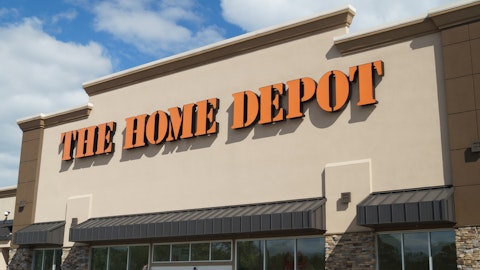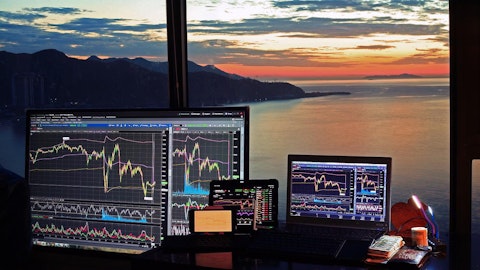The Sherwin-Williams Company (NYSE:SHW) Q4 2022 Earnings Call Transcript January 26, 2023
Operator: Good morning. Thank you for joining the Sherwin-Williams Company’s Review of Fourth Quarter 2022 results and our outlook for the first quarter and full year of 2023. With us on today’s call are John Morikis, chairman and CEO; Al Mistysyn, CFO; Heidi Petz, President and COO; Jane Cronin, Senior Vice President, Corporate Controller; and Jim Jaye, Senior Vice President, Investor Relations and Communications. This conference call is being webcast simultaneously in listen-only mode by Issuer Direct via the Internet at www.sherwin.com. An archived replay of this webcast will be available at www.sherwin.com, beginning approximately two hours after this conference call concludes. This conference call will include certain forward-looking statements as defined under the U.S. federal securities laws with respect to sales, earnings and other matters.
Any forward-looking statement speaks only as of the date on which the statement is made, and the company undertakes no obligation to update or revise any forward-looking statement whether as a result of new information, future events or otherwise. A full declaration regarding forward-looking statements is provided in the company’s earnings release transmitted earlier this morning. After the company’s prepared remarks, we will open the session to questions. I will now turn the call over to Jim Jaye.
Jim Jaye: Thank you, and good morning to everyone. Sherwin-Williams delivered strong fourth quarter results compared to the same period a year ago, including high single-digit percentage sales growth, significant year-over-year gross margin improvement, expanded adjusted operating margins in all three segments, strong double-digit diluted net income per share growth and strong EBITDA growth. Sales in our professional architectural end markets increased by a high-teens percentage. On the industrial side of the business, sales were up by double-digit percentages in North and Latin America, partially offset by softer conditions in Europe and Asia. From a cost perspective, year-over-year inflation remained significant in the quarter, but we are encouraged by a modest sequential decrease in raw material costs for the second quarter in a row.
Additionally, we made solid progress on the targeted restructuring and cost reduction actions we announced on our last call, the results of which we expect to begin benefiting us in the first half of 2023. Throughout the quarter, we remain focused on customer solutions and executing on continuous improvement in business optimization activities. We also identified opportunities and prepared for what we currently expect will be a challenging operating environment in 2023. I’d like to highlight just a few of our consolidated fourth quarter numbers. Comparisons in my comments are to the prior year period unless stated otherwise. Starting with the top line. Fourth quarter 2022 consolidated net sales increased 9.8% to $5.23 billion. Consolidated gross margin increased to 42.7%, an improvement of 320 basis points.
SG&A expense as a percentage of sales decreased by 40 basis points to 29.8%. Excluding onetime costs related to our previously announced restructuring actions, gross margin improved sequentially to 42.9% in the fourth quarter of ’22 from 42.8% in the third quarter of ’22. And SG&A as a percentage of sales decreased 110 basis points as compared to the prior year. Consolidated profit before tax increased $186 million or 60.2%. Diluted net income per share in the quarter was $1.48 per share versus $1.15 per share a year ago. Excluding Valspar acquisition-related amortization expense and costs related to previously announced restructuring actions, fourth quarter adjusted diluted net income per share increased 41% to $1.89 per share versus $1.34 a year ago.
Adjusted EBITDA in the quarter increased $281 million or 52.7%. Let me now turn it over to Heidi, who will provide some commentary on our fourth quarter results by segment. John will follow Heidi with his comments on our full year 2022 results as well as our 2023 outlook before we move on to your questions.
Heidi Petz: Thank you, Jim. I’ll begin with the Americas Group, where sales increased 15.7% driven by mid-single-digit volume growth and continued effective pricing. Segment profit increased by $126.4 million and segment margin improved 210 basis points to 17.2%. Our pro architectural sales grew by a high teens percentage of the quarter, led by property management and followed by new residential, commercial and residential repaint, respectively. Sales in Protective & Marine, DIY and Latin America, all increased by double digits, but were below the TAG segment guided range. From a product perspective, interior and exterior paint sales were both strong, with interior sales growing faster and representing a larger part of the mix.
We opened 40 net new stores in the fourth quarter and a total of 72 net new stores in 2022. Moving on to our Consumer Brands Group. Sales decreased by 2.4% in the quarter, which was better than our guidance. Sales decreased due to lower volume sales and low single-digit FX headwinds, partially offset by price increases. Sales were slightly positive in North America and Europe, but more than offset by significant continued weakness in China due in large part to COVID-related lockdown. Customers managed their inventories as inflation continued to pressure DIY paint demand from consumers for this segment. Tightness in alkyd resin also impacted our ability to produce stains and aerosols. Adjusted segment margin was 11.3%, up 500 basis points year-over-year.
We also made good progress in the quarter on the China architectural and aerosol restructuring actions that we described last quarter. The actions in the fourth quarter resulted in $25.6 million in onetime restructuring costs and a $15.5 million impairment charge. Sales in the Performance Coatings Group increased 4.2% and were driven by mid-teens pricing, partially offset by a low double-digit decrease in volume. Mid-single-digit sales from acquisitions were offset by a mid-single-digit unfavorable FX impact. Adjusted segment margin increased 530 basis points to 14.2% of sales. This is the third straight quarter that this team has delivered year-over-year segment margin improvement driven by execution of our strategy, including effective pricing actions.
Sales in PCG varied significantly by region. In North America, sales increased double digits against a challenging comp. Latin America sale also increased by double digits against a strong comp. Sales in Europe decreased high-single-digits against a double-digit comparison and amidst continued economic slowing. Sales decreased by a low teens percentage in Asia against a double-digit comparison and as COVID lockdowns continued to impact demand. From a division perspective, Growth was strongest in coil, which was up by a low double-digit percentage, followed by auto refinish and general industrial, which were both up mid-single digits. Packaging was down low single digits driven by negative double-digit FX impact in Europe and Asia and against an extremely strong comparison last year of over 30%.
We continue to feel very good about our packaging position and expect this to be a recession-resilient performer. Industrial wood was down low teens as the housing slowdown is impacting furniture, flooring and cabinetry market. Similar to Consumer Brands Group, Performance Coatings made good progress on its portion of the targeted restructuring actions that we described on our last call, resulting in $22.2 million in onetime costs in the quarter. With that, let me turn it to John for his comments on our full year results and our 2023 outlook.
John Morikis: Thank you, Heidi, for that color on our fourth quarter segment results. I want to thank our teams for working hard to deliver a strong finish to the year. I’m particularly pleased with the significant adjusted profit margin improvement that all three segments delivered compared to the fourth quarter a year ago. Our fourth quarter completed a strong year for Sherwin-Williams and I’d like to provide just a few high-level comments on our full year performance. On a consolidated basis, we delivered record sales, adjusted EBITDA and adjusted diluted net income per share in 2022. We generated these results in a difficult operating environment, including relentless inflation, less-than-optimal raw material availability, a war in Europe and COVID lockdowns in China.
Our people refused to be deterred by these challenges and continue to do what they do best, serve our customers. Our success stems from executing on our strategy, which remains unchanged. We provide differentiated solutions that enable our customers to increase their productivity and their profitability. These solutions center on industry and application expertise, innovation, value-added services and differentiated distribution. None of this happens without the determination and dedication of our greatest asset, the more than 61,000 employees of Sherwin-Williams. Together, this team grew full year consolidated sales by 11.1% to a record $22.1 billion. It was the 12th consecutive year we have grown the business. On a segment basis, the Americas Group delivered 12.9% sales growth and grew profit before tax $197.5 million.
Our largest customer segment, residential repaint, grew by a double-digit percentage for the seventh year in a row. Sales in all other customer segments were also up by double digits for the year. Consumer Brand sales were down 1.1% for the year. Sales were up mid-single digits in North America, our largest region. This was more than offset by double-digit declines in Europe and China. Although the bottom line results weren’t what we expected, 2022 was a transition year for Consumer Brands Group as they completed a number of restructuring and simplification efforts to position the business for long-term success and driving operating margins back to the high teens. Performance Coating sales were up 13.2% for the year against a 22% comparison.
All divisions grew with the exception of industrial wood. It was down less than 1%. Adjusted segment margin expanded 250 basis points to 14.1% for the year as we continue to recover from the highest cost inflation in the company and pursue our high-teens margin target for this segment. Adjusted diluted net income per share increased 7.1% to a record $8.73 per share. Adjusted EBITDA for the year was $3.61 billion or 16.3% of sales. Net operating cash for the year was $1.9 billion or 18.7% of sales. We returned a total of $1.5 billion to our shareholders in the forms of dividends and share buybacks in 2022. We invested $883 million to purchase 3.35 million shares at an average price of $263.64. We distributed $618.5 million in dividends, an increase of 5.4%.
We also invested $644.5 million in our business through capital expenditures, including approximately $188 million for our building our future projects. We ended the year with a net debt to adjusted EBITDA ratio of 2.9 times. Additionally, we invested $1 billion in acquisitions that accelerated our strategy. I’d also like to mention our ESG efforts where we continue to work toward meeting our longer-term targets. Newsweek, Forbes and other third parties once again recognized various aspects of our program. Throughout the year, we continue to execute on continuous improvement initiatives and targeted investments to drive growth, competitiveness, efficiency and profitability. We opened 72 new paint stores and hired 1,400 management trainees. We introduced multiple new products while reducing SKUs and formulations.
We expanded production capacity and enhanced procurement and logistics processes. We also continued on our digital and sustainability journeys, and we executed on our acquisition strategy. I am confident we widened the gap between Sherwin-Williams and our competitors in 2022, and that’s just what we intend to do again in 2023. So turning to our outlook. We enter 2023 with confidence, energy and a commitment to seize profitable growth opportunities wherever we find them. We have clarity of mission. We have the right strategy. We’re focused on solutions for our customers. We’re spending more time selling products and less time sourcing them, thanks to recovery in the supply chain. We’re simplifying the business, and we’re executing on targeted restructuring actions.
We’ve made the right growth investments, and we’ll continue to do so. We also have a portfolio that should be more resilient than in prior recessions. And above all, we’ve got the right people. We expect to outperform the market just as we have in the past. At the same time, we’re not operating with our heads in the sand. We currently see a very challenging demand environment in 2023, and visibility beyond our first half is limited. The Fed has also been quite clear about its intention to slow down demand in its effort to tame inflation. These factors have not changed from what we communicated on our third quarter call and our base case in 2023 remains to prepare for the worst. Based on current indicators, we believe this is the most realistic outlook at this time.
On the architectural side, it’s no secret that U.S. housing will be under significant pressure this year. Single-family permits have been down year-over-year for 10 consecutive months, and single-family starts have been down year-over-year for eight consecutive months. Mortgage rates also remain elevated. As a result, we believe our new residential volume could be down anywhere from 10% to 20% this year. We expect our other PRO end markets to be more resilient than this, but there are headwinds in these areas, too. For example, existing home sales, which drive a portion of our repaint business have declined year-over-year for 16 straight months. Now while we see a backlog of new commercial construction, the Architectural Billing Index has contracted the last three months.
On the DIY side, we expect inflation to continue putting pressure on consumer behavior in the U.S. and in Europe. On the industrial side, the PMI numbers for manufacturing in the U.S., Europe, China and Brazil have been negative for multiple months. We have already seen an industrial slowdown in Europe and the same is beginning to appear in the U.S. across several sectors. In China, COVID remains a wildcard and the trajectory of economic recovery is difficult to map. The U.S. housing slowdown will also impact some of our industrial businesses, namely industrial wood where we have already seen pressure and coil to some extent. Our team fully understands the importance of winning new accounts and growing share of wallet in this environment, and that is where we will be focused.

From a cadence standpoint, we expect year-over-year sales and earnings performance will be significantly better in the first half than in our second half, driven by several factors. Our total company comparison will be much more favorable in the first half of 2023 as we delivered a very strong second half performance in 2022, where sales were up 13.8% and adjusted earnings per share grew by over 37%. As we’ve often said, volume is the key driver for operating leverage in our model. In the Americas Group, which is our largest and most profitable segment, our year-over-year volume comparisons are expected to be meaningfully better in the first half versus in the second half based on the trends we are currently seeing. We also expect more carryover price in the first half of 2023, which will have the full benefit of our September 6, 2022 price increase in TAG as well as prior price increases in the other two segments, all of which will annualize in the back half of this year.
Additionally, we expect new residential sales will hold up better in our first half before very meaningful deceleration of demand in the back half of the year. Acquisitions will also be a tailwind in our first half as we expect incremental sales of approximately $140 million from transactions which closed after July 1 of last year. Given these factors and the softening demand environment, we believe our expectations for the back half of 2023 are tempered appropriately at this time. As you would expect, we will gain more clarity as the year progresses, and we will provide a more finally tuned view of our second half outlook during our second quarter conference call. As we said on our last call, we anticipated the demand environment would be challenging in 2023, leading us to get out ahead on cost management with the targeted restructuring we began in the fourth quarter.
We estimate the annual savings from this effort to be in the $50 million to $70 million range, with about 75% realized by the end of 2023, and we are reaffirming those estimates today. Our outlook also assumes our raw material costs will be down by a low to mid-single-digit percentage in 2023 compared to 2022. We expect to see the largest benefit occurring in the second and third quarters. We expect to see decreases across many commodity categories, though the ranges likely will vary widely. From an availability standpoint, certain alkyd resins remain a pain point, impacting stains, aerosols and some industrial products. We expect supply of these resins to continue improving through the first half of the year, in part due to ramping of our own internal production.
We expect other costs, including wages, energy and transportation to be up in the mid to high single-digit range. For the first quarter of 2023, we anticipate our consolidated net sales will be flat to up by a mid-single-digit percentage compared to the first quarter of 2022, inclusive of a mid-single-digit price increase. Our sales expectations for the quarter by segment are included in our slide deck. For the full year 2023, we expect consolidated net sales to be flat to down mid-single digits, inclusive as a mid-single-digit price of carryover from 2022. Our sales expectations for the year by segment are included in our slide deck. We expect diluted net income per share for 2023 to be in the range of $6.79 to $7.59 per share. Full year 2023 earnings per share guidance includes acquisition-related amortization expense of approximately $0.81 per share and includes expense related to our previously announced targeted restructuring actions of approximately $0.25 to $0.35 per share.
On an adjusted basis, we expect full year 2023 earnings per share in the range of $7.95 to $8.65. We provided a GAAP reconciliation in the Reg G table within our press release. Let me close with some additional data points and an update on our capital allocation priorities. Given carryover pricing, raw material deflation and our ongoing continuous improvement initiatives, we would expect full year gross margin expansion. We expect SG&A as a percent of sales to increase in 2023. This is similar to the slowdown in 2008 and 2009, where we continue to invest in long-term solutions for our customers that allowed us to grow at a multiple of the market when demand normalized. We’ll also control costs tightly in non-customer-facing functions and execute on our restructuring initiatives.
We have a variety of SG&A levers we can pull depending on a material change to our outlook up or down. We expect operating margin to modestly improve year-over-year, excluding restructuring and impairment costs and acquisition-related amortization expense. While we don’t typically provide this level of color, we believe it is helpful to do so this year given the higher level of non-operating expenses impacting 2023. We expect to open between 80 to 100 new stores in the U.S. and Canada in 2023. We’ll also be focused on sales reps, capacity and productivity improvements as well as systems and product innovation. We expect to complete the targeted restructuring actions we announced on our previous call, including the benefits and onetime costs we have outlined.
We will continue to simplify and optimize the organization. The Latin American business of the Americas Group is now being managed and reported within the Consumer Brands Group. The change allows TAG leadership to focus more exclusively on its core U.S. and Canada stores business. While the Latin America architectural demand and service model are trending to be more in line with CBG’s strategy. This business had sales of approximately $700 million in 2022. The change will be marginally accretive to TAG and marginally dilutive to CBG. You will see this change when we report first quarter results in April. Prior-year segment results will be restated at that time to reflect the change. The first quarter and full year guidance for 2023 we’ve communicated today does not reflect this change.
Next month, at our Board of Directors meeting, we will recommend an annual dividend increase of 0.8% to $2.42 per share, up from $2.40 last year. If approved, this will mark the 45th consecutive year we’ve increased our dividend. We expect to continue making opportunistic share repurchases. We do not have any long-term debt maturities due in 2023. However, we will reduce short-term debt to trend our adjusted EBITDA leverage ratio towards the high end of our long-term target of 2 to 2.5 times. We’ll also continue to evaluate acquisitions that fit our strategy. In addition, I will refer you to the slide deck issued with our press release this morning, which provides guidance on our expectations for currency exchange, effective tax rate, CapEx, depreciation and amortization and interest expense.
Given the many variables at play, limited visibility beyond the first half and the high level of uncertainty in the global economy, we believe our outlook is a realistic one. Our slide deck further outlines the assumptions underlying our guidance and is based on our current dialogue with customers and suppliers and our reading of numerous macro indicators. As we get through our first half and we see more information, those assumptions could change. If those assumptions change for the better, we would expect to do better than the guidance we are laying out today. While we can’t defy gravity, we do expect to outperform the market and our competitors in 2023. I’m highly confident in our leadership team, which is deep and experienced and has been through many previous business cycles.
We’ve transformed our business in many ways since the last significant downturn, and we are now a stronger and a more resilient company. We also know our guidance is clearly reflective of the market pressure we are experiencing. We anticipated 2023 would be challenging. We’ve planned accordingly. We have and will continue taking appropriate actions. We expect strong momentum coming out of this period of uncertainty, similar to prior downturns. That momentum will stem from our strategy of providing innovative solutions that help our customers to be more productive and more profitable. In challenging environments, like the current one, we can be an even more valuable partner to our customers, while we’re also earning new ones. This concludes our prepared remarks.
With that, I’d like to thank you for joining us this morning, and we’ll be happy to take your questions.
See also 10 Dirt Cheap Stocks To Buy and 13 Cheap New Stocks To Buy.
Q&A Session
Follow Sherwin Williams Co (NYSE:SHW)
Follow Sherwin Williams Co (NYSE:SHW)
Operator: our first question is coming from Christopher Parkinson from Mizuho. Your line is live.
Christopher Parkinson: Great. Thank you so much for taking my question. On Slide 8, you have some pretty helpful framework specifically on TAG volumes. John, obviously, you’ve been discussing this for a while, but can you just talk about the differences, obviously, what you’re seeing in the new resi side, which is a little bit smaller but what you’re hearing from your team regarding the pent-up demand on the resi repaint side. How you feel about that versus a quarter, 6 months ago and how that shapes up throughout 2023. Thank you so much.
John Morikis: Sure, Chris. I’ll start with new residential. And what I’ll do is I’ll talk a little bit about new res and I’ll hand it over to Heidi to talk a little bit about her view. She’s obviously working closely with her teams, and then I’ll pick back up on res repaint we’ll do the same. New res, I would start with a very important fact that over the last 10 years, we’ve had a 10 year compounded growth rate of about 10.5%. So this has been an area of focus for us, and it’s one where we have, I think, clearly demonstrated significant success, and we are determined to continue to drive that success. Permits and starts are down as we all know. And our relationships with our national builders are strong and getting stronger. There’s a lot going on, and we’re working closely with them. Heidi, why don’t I give that to you? And maybe you could talk a little bit about what you’re working on, on the new residential side?
Heidi Petz: Yes, sure. No, I think the last 10 years that John referred to has really put us in a strong position in new res. And we have every intention of aggressively pursuing share gains, especially during what we will consider to be pretty choppy waters ahead. We’re going to continue to focus on growing our exclusive relationships. And I would expect that we’re going to add to an already strong percentage of mutually beneficial exclusive relationship. For example, we look at our partnerships here pretty broadly and these builders that we’re working with. It’s really allowing us to collaborate in areas such as reducing complexity simplification and importantly, execution and utilizing our store platform, our technology, our supply chain and also importantly, our technical teams, we’re really partnering to help these builders to respond to today’s challenges and really helping them to reach their goals.
So ultimately, reducing complexity may assist in their efforts to drive efficiency and productivity. And new products really play the key role in the help assist during some of these challenging times. For example, we’re going to be introducing extreme build — an extreme high build interior latex. And in a segment that’s going to be under pressure, you may be asking yourself why we’re bringing new products. But to be truthful, this is where we do help our customers win. This extreme high build lets the contractor build eight to 12 mils wet film thickness versus the more conventional four to six mils. So if you can imagine, just minimizing surface imperfections and excellent touch up, especially in an environment where labor is a challenge and an issue for these drywallers and painters.
This product is helping to hide the spends of what I would call maybe less experienced drywallers and really improve the speed for painters. So essentially, everyone is winning here. So you can kind of ask what to expect. John mentioned this earlier, the rate increases will pressure our builders, and we will grow share, but we were not going to be immune to the impact of these rates. We’re going to respond to these changes. And I would expect that our builders will do the same. They may adjust floor plans. Many are looking at standardization, but no one will respond like Sherwin-Williams. We’re going to take this expertise. We’re going to aggressively go to builders that may have relationships with some of our competition. And we’re going to demonstrate these capabilities in a way that will allow us to grow share.
So while in the short term, we’ll likely feel pressured. We like the favorable demographics. The existing housing shortage gives us a great deal of confidence that our strong and growing position in new res will benefit our shareholders. So we look at the strong business through both a short and long-term lens. I would say in the short term, given our success and our position in the market, and we may over-index right now while we’re working through some of the short-term choppiness. But in the long term, make no mistake, we do believe that this is in our best interest to continue to pursue these important gallons.
John Morikis: I think maybe just one more point or two points maybe on new res, Chris, to Heidi’s point, I think our relationships with the new residential contractors, they’re reaching new highs. I mean we’re collaborating and working together. She mentioned, one of the new products that we’re introducing, I think there’s a steady stream of introductions of not only products, but services and collaboration that we think really helps us help our customers. And the other point Heidi is really driving with her team, Justin Binns, our Group President of our TAG business is really taking this terrific work in products and services beyond the large national homebuilders and even driving that down further into the regional builders, where there is terrific opportunity for growth.
And so while we expect there will be choppiness in the new residential, and I think it’s important to say this beyond just new residential. We’re not just reporting things are tough and low as us. So that’s not who we are. We expect it’s going to be tough, and we’re going to come out fighting and swinging aggressively. And so yes, we do well with a lot of the large national homebuilders. We’re going to be fighting like crazy after these regionals and other customers that we don’t have. We expect new residential if you look at some of the information that’s out there to be down in the 20% to 30% range. That’s not what we’re expecting for our business. That’s what we see in housing starts. So actually, what we’re saying is that the homebuilders are posting some of them in the 20% to 30% range, we expect to outperform that and bring in a much better number than that.
But we’ll feel the pressure. We get really quick to the res repaint side, and we won’t go through each of the segments with such depth. But I do think that, Chris, your point is, your question is right on point, given the headlines, if you will, that these two segments will play for us this year. In residential repaint, we would say that while we continue to grow, and again, another area of focus over the 10 years, our compounded growth here has been 11% — a little over 11.5%. We do expect to see some deceleration in the annual gains. If you look at the LIRA and the NAHB projections they are positive, but at a decelerated rate largely tied to existing home sales. But this is also an area where people continue to invest. Painting remains a relatively inexpensive investment but a very impactful project, that along with the aging housing stock and home price appreciation, we think will have a positive effect on this business.
But Heidi, maybe you could talk a little bit about res repaint, and some of the work you and your team are driving there.
Heidi Petz: Well, part of the fact that we’ve built really strong momentum here. I think this is certainly not by chance, but by design continuing to develop innovative products. John referenced some of the services, innovative solutions to differentiate ourselves and we couldn’t do it without our incredible team. Our managers are reps, they play an extremely significant role in all segments, but I would argue in the res repaint segment, which really responds well to our high-touch personal service really can help to differentiate our model. We often talk about our secret weapon is our people. And I think clearly on display as we’re helping our customers navigate through unprecedented challenges for them as well and challenges such as labor when res repaint, our full product line really allows contractors to step up in quality, helping to compensate for some less experienced applicators.
And as we continue to see our customers do step up in quality, the results are clear that they are becoming more successful. And we’re helping them prepare for some choppiness ahead, I would say, in addition to the whole product line, preparing for some new substrates. I’ll give you an example here. In homes where our res painting, we’re in the midst of rolling out a new kitchen cabinet refinish paint product. So if you think of the homeowners that are affected by certainly higher costs and not willing to replace entire cabinet systems, but willing to refinish their existing cabinets, we’re helping contractors to serve these clients with some profitable solutions. So amongst our new products, we’re going to be introducing a self-cleaning Exterior Woods capes Stain as well for the exterior, which I just mentioned.
So each and every rain will have a home looking freshly painted. So literally, the dirt will wash away with every rain, which is a pretty incredible technology, and we’ll look like a newly painted home. So our position in res repaint continues to improve. In fact, we continue to not only grow share but accelerate some of these share gains. So while the bid activity has adjusted, overall, it’s still strong. Our average job size is increasing, and our focus continues to be and will be on new accounts and share of wallet.





